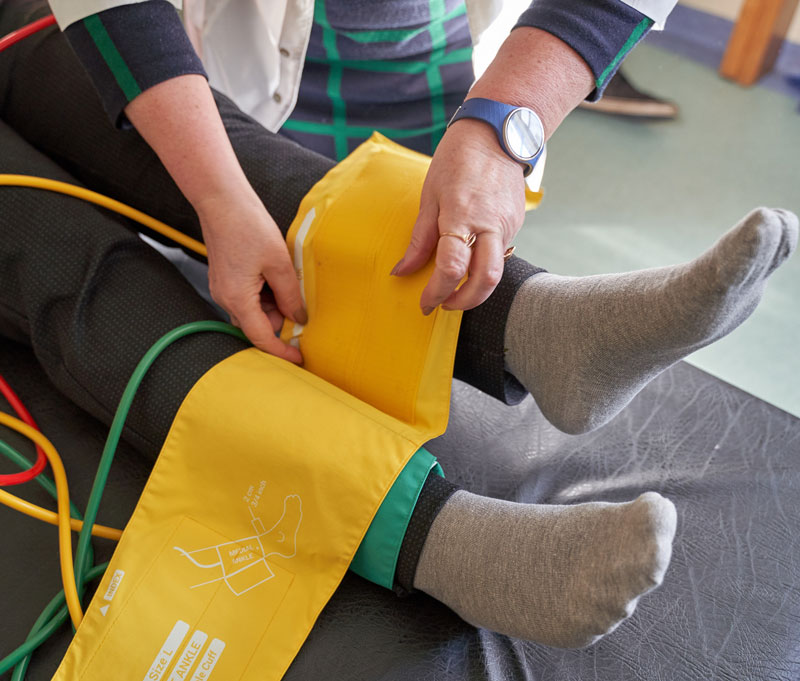Critical limb ischemia (CLI), a condition characterized by the narrowing or blocking of arteries that lead to the legs, is the most severe form of peripheral artery disease (PAD) and a leading cause of lower-limb amputation. Moreover, patients with CLI have high mortality rates. As such, early diagnosis and treatment are key, according to a scientific statement recently published by the American Heart Association (AHA) in its journal, Circulation.
The AHA/American College of Cardiology (ACC) guidelines for lower extremity PAD define CLI as the presence of ischemic rest pain, nonhealing wound/ulcer, or gangrene for >2 weeks with associated evidence of hypoperfusion as measured by ankle-brachial index (ABI), ankle pressure, toe-brachial index (TBI), toe systolic pressure, transcutaneous oximetry (TcPo2), or skin perfusion pressure (SPP). Toward this end, the scientific statement discusses the strengths and limitations of the noninvasive measures outlined in the AHA/ACC guidelines and then identifies opportunities for technology improvement and the reduction of disparities in detection and treatment that have been identified among different races/ethnicities and gender.
ABI is the most-used measure to assess blood flow, and can be used to prognose risk of death, heart attack, and stroke, the statement authors note. However, limitations exist. For example, a Michigan statewide registry of 5,984 patients with CLI who underwent revascularization indicates that 21% had normal ABI and 53% had only mildly reduced ABI—despite having partially compressible arteries. Nor is ABI a good predictor of wound healing or major adverse limb events.
Toe pressure and TBI are currently recommended tests to diagnose and manage CLI. Studies show that both are more accurate than ABI for detecting CLI in patients with heavily calcified and poorly compressible arteries and that toe pressure may be a better predictor of major adverse limb events and tibial disease in patients with CLI compared to ABI and ankle pressure. However, neither ABI nor TBI quantify oxygenation. Additional limitations of TBI include the lack of a consensus threshold and the lack of “solid evidence with core laboratory—adjudicated wound healing data for ABI or TBI to assess the sensitivity and specificity of these tests as perfusion tools to assess wound healing or limb salvage,” the authors state.
TcPo2 measures oxygen tension and SPP measures capillary opening pressure. Although they are more advanced measures, they are not widely available and have numerous limitations. Both can be used to predict wound healing, according to single-center data.
Among the experimental technologies being explored to improve the precision and quality of CLI management are CT perfusion, MRI, contrast-enhanced ultrasound, and hyperspectral imaging, all of which are noninvasive, and indigo carmine angiography, which is an invasive procedure. The authors also mention that an investigational implantable device that measures tissue oxygen levels is currently undergoing clinical trials in the US. The Lumee Oxygen Platform (Profusa, Emeryville, CA) is a micro-oxygen biosensor that is injected permanently into the tissue of concern, allowing for continuous, real-time monitoring of tissue oxygen levels. It has been shown to be safe and effective in a small-scale study; larger studies are needed.
The statement also identifies CLI/PAD patient population disparities as another area with room for improvement in the management and treatment of the disease. For example, women are underrepresented in clinical studies despite the fact that more women than men present with PAD, and that they are also more likely to be admitted to emergency hospitalization due to PAD and to present with CLI, and they have higher mortality rates after lower-limb revascularization or amputation. Regarding racial/ethnic disparities, the statement notes that black and Hispanic patients have higher prevalence of diabetes and chronic renal disease and are more likely to present with gangrene, whereas white patients are more likely to present with ulcers and rest pain. Black patients are also 78% more likely to undergo amputation for CLI than white patients, even after adjustment for comorbidities, socioeconomic status, and access to facilities with revascularization capacity.
Despite estimations that 12 million people in the US are affected, strategies to assess blood flow are limited. The authors concluded by highlighting the importance of incorporating perfusion assessment into the care of CLI patients, their belief that new technologies offer potential opportunities to improve the precision and quality of CLI management, and that technology through telemedicine could help to decrease disparities in the care of patients with PAD.
Source: Misra S, Shishehbor MH, Takahashi EA, et al, and on behalf of the American Heart Association Council on Peripheral Vascular Disease; Council on Clinical Cardiology; and Council on Cardiovascular and Stroke Nursing. Perfusion assessment in critical limb ischemia: principles for understanding and the development of evidence and evaluation of devices: a scientific statement from the American Heart Association. Circulation. 2019: 2019;140:e657–e672.










